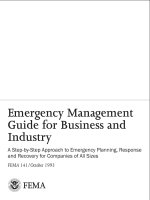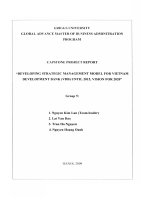Strategic management planning for domestic and global competition 14th ed pearce robinson chapter 11
Bạn đang xem bản rút gọn của tài liệu. Xem và tải ngay bản đầy đủ của tài liệu tại đây (483.67 KB, 32 trang )
Chapter 11
Organization
Structure
© 2015 by McGraw-Hill Education. This is proprietary material solely for authorized instructor use. Not authorized for sale or distribution in any manner. This document may not be copied, scanned, duplicated, forwarded, distributed, or
posted on a website, in whole or part.
Learning Objectives
1.
2.
Identify five traditional organizational structures and the pros and cons of each
Describe the product-team structure and explain why it is a prototype for a more
open, agile organizational structure
3.
Explain five ways improvements have been sought in traditional organizational
structures
4.
Describe what is meant by agile, virtual organizations
2
Learning Objectives (contd.)
5.
Explain how outsourcing can create agile, virtual organizations, along with its pros and
cons
6.
7.
Describe boundaryless organizations and why they are important
Explain why organizations of the future need to be ambidextrous learning organizations
3
Organizational Structure
•
Organizational structure refers to the formalized arrangement of interaction
between and responsibility for the tasks, people, and resources in an
organization
4
Simple Organizational Structure
•
•
•
A simple organizational structure is one where there is an owner and a few employees and
where the arrangement of tasks, responsibilities, and communication is highly informal and
accomplished through direct supervision
This type of structure can be very demanding on the owner-manager
Most businesses in this country and around the world are of this type
5
Functional Organizational Structure
•
A functional organizational structure is one on which the tasks, people, and
technologies necessary to do the work of the business are divided into separate
“functional” groups (such as marketing, operations, and finance) with increasingly
formal procedures for coordinating and integrating their activities to provide the
business’s products and services.
6
Ex. 11.3
Functional Organization Structures
7
Divisional Structure
•
A divisional organizational structure is one in which a set of relatively autonomous units, or
divisions, are governed by a central corporate office but where each operating division has
its own functional specialists who provide products or services different from those of other
divisions
8
Divisional Structure (contd.)
•
•
This structure expedites decision making in response to varied competitive
environments
The division usually is given profit responsibility
9
Ex. 11.4
Divisional Organization Structure
10
Strategic Business Unit
•
The strategic business unit (SBU) is an adaptation of the divisional structure
whereby various divisions or parts of divisions are grouped together based on some
common strategic elements, usually linked to distinct product/market differences
•
The advantages and disadvantages of the SBU form are very similar to those
identified for divisional structures
11
Holding Company Structure
•
A final form of the divisional organization is the holding company structure, where
the corporate entity is a broad collection of often unrelated businesses and divisions
such that it (the corporate entity) acts as financial overseer “holding” the ownership
interest in the various parts of the company but has little direct managerial
involvement
12
Matrix Organizational Structure
•
The matrix organizational structure is one in which functional and staff
personnel are assigned to both a basic functional area and to a project or
product manager
•
The matrix form is intended to make the best use of talented people within
a firm by combining the advantages of functional specialization and
product-project specialization
13
Ex. 11.5
Matrix Organizational Structure
14
Ex. 11.5 (adapted)
Matrix Organizational Structure (contd.)
15
Product-Team Structure
•
The product-team structure seeks to simplify and amplify the focus of resources on
a narrow but strategically important product, project, market, customer, or
innovation
•
The product-team structure assigns functional managers and specialists to a new
product, project, or process team that is empowered to make major decisions about
their product
16
Ex. 11.7
The Product-Team Structure
17
Trends Affecting Organizations in the 21st Century
•
Globalization
•
The Internet
•
Speed
18
Ex. 11.9
What a Difference a Century can Make
19
Efforts to Improve Traditional Structures
•
Redefine the role of corporate headquarters from control to support and
coordination
•
Balance the demands for control/differentiation with the need for
coordination/integration
•
•
•
Restructure to emphasize and support strategically critical activities
Reengineer strategic business processes
Downsize and self-manage
20
Restructure to Emphasize and Support Strategically Critical Activities
•
•
Restructuring: Redesigning an organizational structure with the intent of
emphasizing and enabling activities most critical to a firm’s strategy to function
at maximum effectiveness.
Business Process Reengineering: A customer-centric restructuring approach. It
involves fundamental rethinking and radical redesigning of a business process so
that a company can best create value for the customer by eliminating barriers
that create distance between employees and customers.
21
Restructure to Emphasize and Support Strategically Critical Activities (contd.)
•
•
Downsizing: Eliminating the number of employees, particularly middle
management, in a company.
Self-management: Allowing work groups or work teams to supervise and
administer their work as a group or team without a direct supervisor exercising
the supervisory role. These teams set parameters of their work, make decisions
about work-related matters, and perform most of the managerial functions
previously done by their direct supervisor.
22
Creating Agile, Virtual Organizations
•
•
Virtual organization: a temporary network of independent companies—suppliers,
customers, subcontractors, even competitors—linked primarily by information
technology to share skills, access to markets, and costs
An agile organization is one that identifies a set of business capabilities central to highprofitability operations and then builds a virtual organization around those capabilities
23
Outsourcing—Creating
a Modular Organization
•
•
•
Outsourcing is simply obtaining work previously done by employees inside the
companies from sources outside the company
A modular organization provides products or services using different, self-contained
specialists or companies brought together—outsourced—to contribute their primary or
support activity to result in a successful outcome
Business process outsourcing (BPO) is the most rapidly growing segment of the
outsourcing services industry worldwide
24
Strategic Alliances
•
Alliances with suppliers, partners, contractors, and other providers that allow partners in
the alliance to focus on what they do best, farm out everything else, and quickly provide
value to the customer.
25









